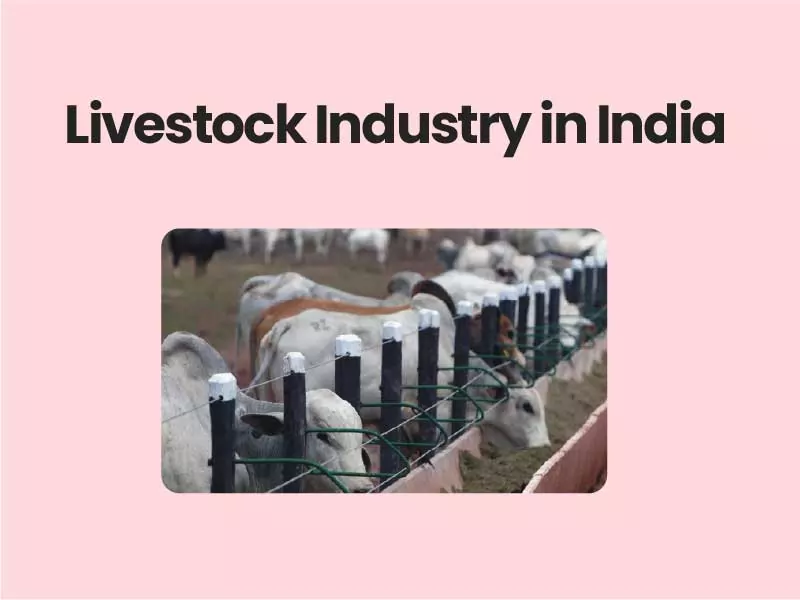Companion@360 → 7 Month programme to sharpen your writing skills → REGISTER NOW

Livestock Industry in India
Why in News?
20th Livestock census has been released recently.
What is Livestock Census?
The Department of Animal Husbandry & Dairying under Ministry of Fisheries, Animal Husbandry & Dairying attributes critical importance to livestock and to the collection and availability of up-to-date and accurate data related to livestock, as they are the vital component of the rural economy. The Livestock Census is the main source of such data in the country. It is conducted across the country periodically since 1919. The census usually covers all domesticated animals and headcounts of these animals are taken.
- The 20th Livestock Census was launched during the month of October 2018.
- The enumeration was done in both rural and urban areas.
- Various species of animals (cattle, buffalo, yak, sheep, goat, pig, horse, pony, mule, donkey, camel, dog, rabbit and elephant)/poultry birds (fowl, duck and other poultry birds) possessed by the households, household enterprises/non-household enterprises were counted at that site.
- 20th Livestock Census has been designed to capture Breed-wise number of animals and poultry birds.
- For the first time, livestock data were collected online in 20th Livestock Census
Role of Livestock Industry in India
- Livestock industry plays an important role in the Indian economy. About 2.5-3 crore people depend on it for food.
- It Provides employment.
- Distribution of livestock is more equitable than that of land.
- The livestock sector contributes to low income, small farm, households etc.
- More than three-fourths of the labour demand in livestock production is met by women. The share of women employment in the livestock sector is around 90% in Punjab and Haryana where dairying is a prominent activity and animals are stall-fed.
India is-
- World’s highest livestock owner at about 535.78 million.
- First in the total buffalo population in the world – 109.85 million buffaloes.
- Second in the population of goats – 148.88 million goats
- Second largest poultry market in the world.
- The second-largest producer of fish and also the second-largest aquaculture nation in the world.
- Third in the population of sheep (74.26 million).
- Fifth in the population of ducks and chicken (851.81 million).
- Tenth in camel population in the world – 2.5 lakhs.
Contribution of livestock to people
- Food: The livestock provides food items such as Milk, Meat and Eggs for human consumption. India is the number one milk producer in the world.
- Fibre and skins: The livestock also contributes to the production of wool, hair, hides, and pelts. Leather is the most important product which has very high export potential.
- Draft: Bullocks are the backbone of Indian agriculture. Despite lot of advancements in the use of mechanical power in Indian agricultural operations, the Indian farmer, especially in rural areas, still depends upon bullocks for various agricultural operations.
- Dung and other animal waste materials: Dung and other animal wastes serve as very good farmyard manure and the value of it is worth several crores of rupees
- Storage: Livestock is considered as ‘moving banks’ because of their potentiality to dispose off during emergencies.
- Weed control: Livestock is also used as Biological control of brush, plants and weeds.
Read Also India – Nepal Relations
Role of livestock in Farmers’ economy
Income: Livestock is a source of subsidiary income for many families in India especially the resource-poor who maintain few heads of animals.
Employment: A large number of people in India being less literate and unskilled depend upon agriculture for their livelihoods.
Social security: The animals offer social security to the owners in terms of their status in society.
Food: The livestock products such as milk, meat and eggs are an important source of animal protein to the members of the livestock owners.
Challenges to the livestock industry in India
- The land is only common resource acting as the platform for the development of human and animals. Ever-increasing competition between human and animal for food is a critical challenge in animal rearing.
- The improper and unscientific management of resource like water in animal husbandry makes the increased usage of virtual water in the export market.
- The percolation of extension services regarding animal husbandry is less and negligent
- The low production potential of the indigenous verities of animals is also an added issue.
- Devastating pastures, increased climatic changes, decrease in monsoon rains also makes the animal husbandry vulnerable
- Improper awareness about the vaccination and lack of research in the diseases occurring to animals is also another factor.
- Lack of infrastructure facilities in rural areas like veterinary clinics, breeding centres.
- The absence of credit facilities and insurance coverage schemes makes the farmers show less interest in animal rearing.
- The proper quality checking and standardization of animal products is absent.
Way forward
- Culling of burdening animals.
- Licensing for animal rearing.
- Rejuvenation of Natural Pastures and Grasslands.
- Ensure proper credit facilities.
- The ceiling of Crops breeding.
- Ensure rigorous veterinary extension services.
- Promote Research in organic livestock Farming.
- Special economic zone for the animal husbandry with common facilities must be created for greater export potential.
Conclusion
Indian livestock industry makes up for a significant amount of the world’s livestock resources. Both the national economy as well as the socio-economic growth of the country is backed by the livestock sector. Besides, offering great potential and outstanding contribution to the agricultural sector over the past years. The livestock sector is performing well in the manner of production, value addition and export of dairy, fishery, wool, poultry and other products. Apart from its performance, there are some threats also exist we need to re-correct it and take the global market opportunities.
Read Also Non-governmental organization
